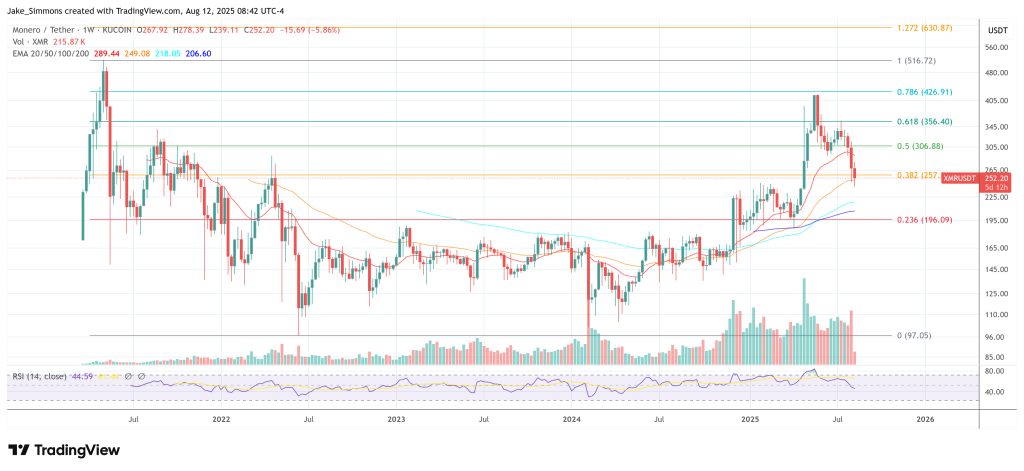Monero (XMR) is confronting what key voices on X describe as a 51% attack from the Qubic mining pool. Bitcoin developer Peter Todd set the tone early, writing: “Interesting. Apparently Monero just had a big reorg too, I assume related to this attack.” When asked whether Qubic had definitively crossed the 51% threshold, Todd cautioned that real-time dominance is hard to pin down: “That’s inherently difficult to measure. PoW is probabilistic.”
Monero Under Siege As Qubic Claims 51% Control
A widely circulated post from an account styling itself as Coffeinated User sketched the alleged playbook and economics in stark terms: “Qubic just reached 51% share of Monero. This is a huge feat. They will be the first to manipulate a cryptocurrency with a 51% attack. They intend to orphan all blocks from every other miner, making themselves the only mining entity of Monero.” The same post asserted a profit-split and buyback/burn mechanic around QUBIC tokens: “They are 3X more profitable than mining Monero directly. They are giving half the profit to miners and selling the other half of the profit to buy QUBIC and send it to the burn wallet.”
It extended the claim into concrete issuance math and dollar figures: “If they mine 100% of the Monero blocks this gives them 432 Monero mined per day. This is $118,342.08 at the current Monero price. They keep 50% of that and give the rest to miners making their profit $59,171.04 of Qubic being burned every day. $414,197.28 burned a week and $1.656 million burned every month. This is insane.” The post concluded with the market-cap juxtaposition: “Qubic a less than 300 million dollar market cap will be the sole miner of a 6 billion dollar market cap coin.”
From the XMR community side, the account @monerobull characterized chain conditions as unprecedented and urged a hash-rate mobilization: “Monero just experienced its deepest re-org ever. Everyone head to gupax.io and start mining. qtip has a halving in 20 days, after which they won’t be able to keep this attack going.”
Hardware-wallet executive Charles Guillemet, CTO at Ledger, summarized the situation and its implications in a long post that did not mince words: “Monero appears to be in the midst of a successful 51% attack.” He tied the moment to Monero’s adversarial history and exchange de-listings: “The privacy-focused blockchain, launched in 2014 and long targeted by governments and 3-letters agencies, is already banned from most major centralized exchanges.”
On the attacker’s capacity, he wrote: “The Qubic mining pool has been amassing hashrate for months and now controls a majority of the network. A major chain reorganization was detected this morning. With its current dominance, Qubic can rewrite the blockchain, enable double-spending, and censor any transaction.”
Guillemet also injected a jaw-dropping back-of-the-envelope cost: “Sustaining this attack is estimated to cost $75 million per day.” He warned of the incentive collapse for honest miners—“Other miners are left with no incentive to continue, as Qubic can simply orphan any competing blocks, effectively becoming the sole miner”—and framed the asymmetry: “In effect, a $300 million market-cap chain is taking over a $6 billion one. Monero’s options for recovery are limited, and a full takeover is now possible and even likely.” As to market reaction, he added: “So far, XMR has dropped only 13%.”
From within the Qubic project, “Come-from-Beyond” (Sergey Ivancheglo) signaled both triumph and a call for third-party validation: “Looks like #Qubic has achieved 51% over #Monero, we are waiting for independent confirmations. In the meanwhile #Monero team is polishing details of their 51% attack protection.”
Responding to earlier accusations about motives, he continued: “Many accused us of being sponsored by 3-letter agencies to attack this anon coin. What do you think now, after we has helped Monero to prepare for its future fights against those agencies?..”
Even as Todd underscores that “PoW is probabilistic” and precise majority measurement is elusive in the moment, the chorus of on-the-record claims from both critics and proponents paints a picture of Monero grappling with a live, majority-hashrate challenge—and a community rushing to counter it in real time.
At press time, XMR traded at $252.

Featured image created with DALL.E, chart from TradingView.com

Editorial Process for bitcoinist is centered on delivering thoroughly researched, accurate, and unbiased content. We uphold strict sourcing standards, and each page undergoes diligent review by our team of top technology experts and seasoned editors. This process ensures the integrity, relevance, and value of our content for our readers.



